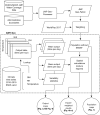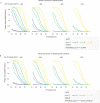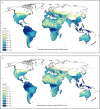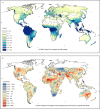Global potential for harvesting drinking water from air using solar energy
- PMID: 34707305
- PMCID: PMC8550973
- DOI: 10.1038/s41586-021-03900-w
Global potential for harvesting drinking water from air using solar energy
Abstract
Access to safely managed drinking water (SMDW) remains a global challenge, and affects 2.2 billion people1,2. Solar-driven atmospheric water harvesting (AWH) devices with continuous cycling may accelerate progress by enabling decentralized extraction of water from air3-6, but low specific yields (SY) and low daytime relative humidity (RH) have raised questions about their performance (in litres of water output per day)7-11. However, to our knowledge, no analysis has mapped the global potential of AWH12 despite favourable conditions in tropical regions, where two-thirds of people without SMDW live2. Here we show that AWH could provide SMDW for a billion people. Our assessment-using Google Earth Engine13-introduces a hypothetical 1-metre-square device with a SY profile of 0.2 to 2.5 litres per kilowatt-hour (0.1 to 1.25 litres per kilowatt-hour for a 2-metre-square device) at 30% to 90% RH, respectively. Such a device could meet a target average daily drinking water requirement of 5 litres per day per person14. We plot the impact potential of existing devices and new sorbent classes, which suggests that these targets could be met with continued technological development, and well within thermodynamic limits. Indeed, these performance targets have been achieved experimentally in demonstrations of sorbent materials15-17. Our tools can inform design trade-offs for atmospheric water harvesting devices that maximize global impact, alongside ongoing efforts to meet Sustainable Development Goals (SDGs) with existing technologies.
© 2021. The Author(s).
Conflict of interest statement
We disclose the following potential competing interests. This work was funded by X, The Moonshot Factory (formerly known as Google[x]). X is a part of Alphabet. Both are for-profit entities. X has filed for patent protection for water-from-air devices, on which multiple authors are listed as inventors. Water-from-air devices may represent significant commercial opportunities upon meeting certain metrics. This work may be pursued further in various ways, including as a possible spinout company in which one or more authors may become founders, officers, shareholders, employees or otherwise involved with a financial interest.
Figures













References
-
- Bain R, Johnston R, Mitis F, Chatterley C, Slaymaker T. Establishing Sustainable Development Goal baselines for household drinking water, sanitation and hygiene services . Water. 2018;10:1711. doi: 10.3390/w10121711. - DOI
-
- Progress on Drinking Water, Sanitation and Hygiene: 2017 Update and SDG Baselines (World Health Organization and the United Nations Children’s Fund, 2017).
-
- Li R, Shi Y, Wu M, Hong S, Wang P. Improving atmospheric water production yield: enabling multiple water harvesting cycles with nano sorbent. Nano Energy. 2020;67:104255. doi: 10.1016/j.nanoen.2019.104255. - DOI
Publication types
LinkOut - more resources
Full Text Sources
Other Literature Sources
Miscellaneous

